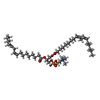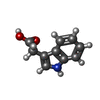+Search query
-Structure paper
| Title | Structures and mechanism of the plant PIN-FORMED auxin transporter. |
|---|---|
| Journal, issue, pages | Nature, Vol. 609, Issue 7927, Page 605-610, Year 2022 |
| Publish date | Jun 29, 2022 |
 Authors Authors | Kien Lam Ung / Mikael Winkler / Lukas Schulz / Martina Kolb / Dorina P Janacek / Emil Dedic / David L Stokes / Ulrich Z Hammes / Bjørn Panyella Pedersen /    |
| PubMed Abstract | Auxins are hormones that have central roles and control nearly all aspects of growth and development in plants. The proteins in the PIN-FORMED (PIN) family (also known as the auxin efflux carrier ...Auxins are hormones that have central roles and control nearly all aspects of growth and development in plants. The proteins in the PIN-FORMED (PIN) family (also known as the auxin efflux carrier family) are key participants in this process and control auxin export from the cytosol to the extracellular space. Owing to a lack of structural and biochemical data, the molecular mechanism of PIN-mediated auxin transport is not understood. Here we present biophysical analysis together with three structures of Arabidopsis thaliana PIN8: two outward-facing conformations with and without auxin, and one inward-facing conformation bound to the herbicide naphthylphthalamic acid. The structure forms a homodimer, with each monomer divided into a transport and scaffold domain with a clearly defined auxin binding site. Next to the binding site, a proline-proline crossover is a pivot point for structural changes associated with transport, which we show to be independent of proton and ion gradients and probably driven by the negative charge of the auxin. The structures and biochemical data reveal an elevator-type transport mechanism reminiscent of bile acid/sodium symporters, bicarbonate/sodium symporters and sodium/proton antiporters. Our results provide a comprehensive molecular model for auxin recognition and transport by PINs, link and expand on a well-known conceptual framework for transport, and explain a central mechanism of polar auxin transport, a core feature of plant physiology, growth and development. |
 External links External links |  Nature / Nature /  PubMed:35768502 / PubMed:35768502 /  PubMed Central PubMed Central |
| Methods | EM (single particle) |
| Resolution | 2.89 - 3.44 Å |
| Structure data | EMDB-14115, PDB-7qp9: EMDB-14116, PDB-7qpa: EMDB-14117, PDB-7qpc:  EMDB-14118: Outward-facing apo-form of auxin transporter PIN8 in detergent |
| Chemicals |  ChemComp-DLP:  ChemComp-HOH:  ChemComp-IAC:  ChemComp-E7O: |
| Source |
|
 Keywords Keywords | MEMBRANE PROTEIN / Auxin transport / AEC family / BART superfamily |
 Movie
Movie Controller
Controller Structure viewers
Structure viewers About Yorodumi Papers
About Yorodumi Papers










